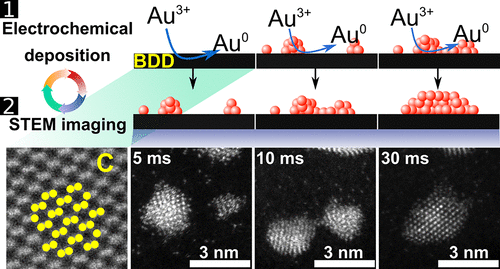Our official English website, www.x-mol.net, welcomes your
feedback! (Note: you will need to create a separate account there.)
Tracking Metal Electrodeposition Dynamics from Nucleation and Growth of a Single Atom to a Crystalline Nanoparticle
ACS Nano ( IF 15.8 ) Pub Date : 2018-07-03 00:00:00 , DOI: 10.1021/acsnano.8b04089 Haytham E. M. Hussein 1 , Reinhard J. Maurer 1 , Houari Amari 2, 3 , Jonathan J. P. Peters 2 , Lingcong Meng 4 , Richard Beanland 2 , Mark E. Newton 2 , Julie V. Macpherson 1
ACS Nano ( IF 15.8 ) Pub Date : 2018-07-03 00:00:00 , DOI: 10.1021/acsnano.8b04089 Haytham E. M. Hussein 1 , Reinhard J. Maurer 1 , Houari Amari 2, 3 , Jonathan J. P. Peters 2 , Lingcong Meng 4 , Richard Beanland 2 , Mark E. Newton 2 , Julie V. Macpherson 1
Affiliation

|
In electrodeposition the key challenge is to obtain better control over nanostructure morphology. Currently, a lack of understanding exists concerning the initial stages of nucleation and growth, which ultimately impact the physicochemical properties of the resulting entities. Using identical location scanning transmission electron microscopy (STEM), with boron-doped diamond (BDD) serving as both an electron-transparent TEM substrate and electrode, we follow this process, from the formation of an individual metal atom through to a crystalline metal nanoparticle, under potential pulsed conditions. In doing so, we reveal the importance of electrochemically driven atom transport, atom cluster formation, cluster progression to a nanoparticle, and the mechanism by which neighboring particles interact during growth. Such information will help formulate improved nucleation and growth models and promote wider uptake of electrodeposited structures in a wide range of societally important applications. This type of measurement is possible in the TEM because the BDD possesses inherent stability, has an extremely high thermal conductivity, is electron beam transparent, is free from contamination, and is robust enough for multiple deposition and imaging cycles. Moreover, the platform can be operated under conditions such that we have confidence that the dynamic atom events we image are truly due to electrochemically driven deposition and no other factors, such as electron-beam-induced movement.
中文翻译:

跟踪从单个原子的成核和生长到结晶纳米粒子的金属电沉积动力学
在电沉积中,关键的挑战是如何更好地控制纳米结构的形貌。当前,对于成核和生长的初始阶段缺乏了解,这最终会影响所得实体的物理化学性质。使用相同的位置扫描透射电子显微镜(STEM),同时将掺硼金刚石(BDD)用作电子透明的TEM衬底和电极,我们遵循此过程,从单个金属原子的形成一直到结晶的金属纳米粒子,在潜在的脉冲条件下。通过这样做,我们揭示了电化学驱动的原子传输,原子团簇形成,团簇向纳米粒子进展以及相邻粒子在生长过程中相互作用的机制的重要性。这些信息将有助于制定改进的成核和生长模型,并促进在广泛的社会重要应用中更广泛地吸收电沉积结构。这种类型的测量在TEM中是可能的,因为BDD具有固有的稳定性,具有极高的导热性,是电子束透明的,没有污染,并且对于多个沉积和成像循环具有足够的鲁棒性。此外,该平台可以在这样的条件下运行:我们有信心我们成像的动态原子事件确实是由于电化学驱动的沉积而没有其他因素,例如电子束诱导的运动。这种类型的测量在TEM中是可能的,因为BDD具有固有的稳定性,具有极高的导热性,是电子束透明的,没有污染,并且对于多个沉积和成像循环具有足够的鲁棒性。此外,该平台可以在这样的条件下运行:我们有信心我们成像的动态原子事件确实是由于电化学驱动的沉积而没有其他因素(例如电子束诱导的移动)引起的。这种类型的测量在TEM中是可能的,因为BDD具有固有的稳定性,具有极高的导热性,是电子束透明的,没有污染,并且对于多个沉积和成像循环具有足够的鲁棒性。此外,该平台可以在这样的条件下运行:我们有信心我们成像的动态原子事件确实是由于电化学驱动的沉积而没有其他因素(例如电子束诱导的移动)引起的。
更新日期:2018-07-03
中文翻译:

跟踪从单个原子的成核和生长到结晶纳米粒子的金属电沉积动力学
在电沉积中,关键的挑战是如何更好地控制纳米结构的形貌。当前,对于成核和生长的初始阶段缺乏了解,这最终会影响所得实体的物理化学性质。使用相同的位置扫描透射电子显微镜(STEM),同时将掺硼金刚石(BDD)用作电子透明的TEM衬底和电极,我们遵循此过程,从单个金属原子的形成一直到结晶的金属纳米粒子,在潜在的脉冲条件下。通过这样做,我们揭示了电化学驱动的原子传输,原子团簇形成,团簇向纳米粒子进展以及相邻粒子在生长过程中相互作用的机制的重要性。这些信息将有助于制定改进的成核和生长模型,并促进在广泛的社会重要应用中更广泛地吸收电沉积结构。这种类型的测量在TEM中是可能的,因为BDD具有固有的稳定性,具有极高的导热性,是电子束透明的,没有污染,并且对于多个沉积和成像循环具有足够的鲁棒性。此外,该平台可以在这样的条件下运行:我们有信心我们成像的动态原子事件确实是由于电化学驱动的沉积而没有其他因素,例如电子束诱导的运动。这种类型的测量在TEM中是可能的,因为BDD具有固有的稳定性,具有极高的导热性,是电子束透明的,没有污染,并且对于多个沉积和成像循环具有足够的鲁棒性。此外,该平台可以在这样的条件下运行:我们有信心我们成像的动态原子事件确实是由于电化学驱动的沉积而没有其他因素(例如电子束诱导的移动)引起的。这种类型的测量在TEM中是可能的,因为BDD具有固有的稳定性,具有极高的导热性,是电子束透明的,没有污染,并且对于多个沉积和成像循环具有足够的鲁棒性。此外,该平台可以在这样的条件下运行:我们有信心我们成像的动态原子事件确实是由于电化学驱动的沉积而没有其他因素(例如电子束诱导的移动)引起的。

































 京公网安备 11010802027423号
京公网安备 11010802027423号